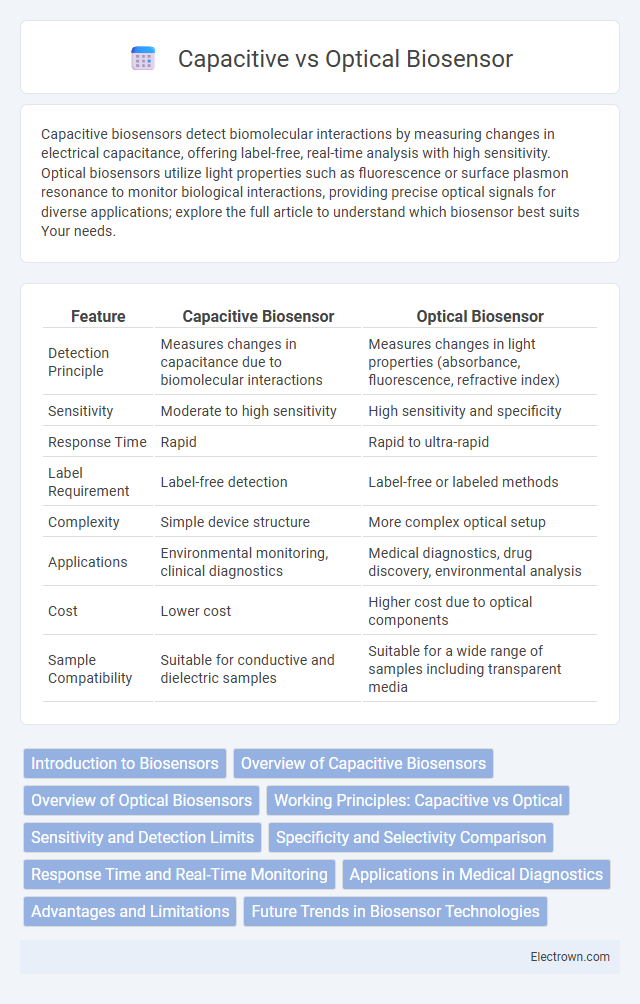Capacitive biosensors detect biomolecular interactions by measuring changes in electrical capacitance, offering label-free, real-time analysis with high sensitivity. Optical biosensors utilize light properties such as fluorescence or surface plasmon resonance to monitor biological interactions, providing precise optical signals for diverse applications; explore the full article to understand which biosensor best suits Your needs.
Table of Comparison
| Feature | Capacitive Biosensor | Optical Biosensor |
|---|---|---|
| Detection Principle | Measures changes in capacitance due to biomolecular interactions | Measures changes in light properties (absorbance, fluorescence, refractive index) |
| Sensitivity | Moderate to high sensitivity | High sensitivity and specificity |
| Response Time | Rapid | Rapid to ultra-rapid |
| Label Requirement | Label-free detection | Label-free or labeled methods |
| Complexity | Simple device structure | More complex optical setup |
| Applications | Environmental monitoring, clinical diagnostics | Medical diagnostics, drug discovery, environmental analysis |
| Cost | Lower cost | Higher cost due to optical components |
| Sample Compatibility | Suitable for conductive and dielectric samples | Suitable for a wide range of samples including transparent media |
Introduction to Biosensors
Biosensors are analytical devices that combine a biological component with a physicochemical detector to identify and quantify substances. Capacitive biosensors measure changes in electrical capacitance caused by the interaction between the target analyte and the bio-recognition element, enabling label-free and real-time detection. Optical biosensors utilize light-based techniques such as fluorescence, surface plasmon resonance, or interferometry to monitor molecular interactions, offering high sensitivity and specificity in various biomedical applications.
Overview of Capacitive Biosensors
Capacitive biosensors detect biomolecular interactions by measuring changes in electrical capacitance at the sensor interface, offering label-free and real-time monitoring of biomolecules such as proteins, DNA, and glucose. These sensors consist of electrodes coated with a biorecognition element, where binding events alter the dielectric properties and surface charge, resulting in measurable capacitance variation. Your selection of a capacitive biosensor can enhance sensitivity and specificity in point-of-care diagnostics and environmental monitoring applications.
Overview of Optical Biosensors
Optical biosensors utilize light-based detection methods such as fluorescence, absorbance, and surface plasmon resonance to measure biological interactions with high sensitivity and specificity. These sensors convert biological responses into optical signals, enabling real-time, label-free analysis crucial for applications in medical diagnostics, environmental monitoring, and food safety. Key advantages include rapid response times, minimal sample preparation, and the capability to detect low concentrations of target analytes.
Working Principles: Capacitive vs Optical
Capacitive biosensors detect changes in dielectric properties at the sensor interface caused by biomolecular interactions, converting these variations into measurable electrical signals. Optical biosensors utilize changes in light properties such as absorption, fluorescence, or refractive index to monitor biological events in real-time. Your choice between capacitive and optical biosensors depends on the required sensitivity, specificity, and detection environment for accurate biomolecular analysis.
Sensitivity and Detection Limits
Capacitive biosensors exhibit moderate sensitivity with detection limits typically in the micromolar to nanomolar range, influenced by electrode surface modifications and dielectric properties. Optical biosensors, such as surface plasmon resonance (SPR) and fluorescence-based systems, offer higher sensitivity, often reaching picomolar or even femtomolar detection limits due to enhanced signal amplification and real-time monitoring capabilities. The superior sensitivity and lower detection thresholds of optical biosensors make them ideal for applications requiring precise quantification of low-abundance biomolecules.
Specificity and Selectivity Comparison
Capacitive biosensors measure changes in dielectric properties at the sensor surface, offering moderate specificity influenced by the functionalization layer, while optical biosensors rely on light interactions such as fluorescence or absorbance, delivering higher selectivity through wavelength-specific detection. Optical biosensors typically achieve greater specificity due to their ability to discriminate target molecules via distinct optical signatures, reducing interference from non-target substances. Your choice depends on the required detection accuracy, with optical biosensors favored for applications demanding precise molecular recognition and capacitive biosensors suitable for label-free, real-time monitoring.
Response Time and Real-Time Monitoring
Capacitive biosensors offer rapid response times due to their direct measurement of changes in dielectric properties, enabling efficient real-time monitoring of biological interactions. Optical biosensors provide instantaneous detection through changes in light properties such as fluorescence or surface plasmon resonance, ideal for continuous, real-time analysis. Your choice depends on whether you prioritize electrical signal speed or high sensitivity in real-time biosensing applications.
Applications in Medical Diagnostics
Capacitive biosensors detect changes in electrical capacitance caused by biomolecular interactions, making them highly effective for monitoring glucose levels and detecting cancer biomarkers in blood samples. Optical biosensors utilize light-based detection methods such as surface plasmon resonance to identify pathogens and analyze DNA sequences with high sensitivity and specificity. Your choice between capacitive and optical biosensors depends on the required sensitivity, sample type, and real-time monitoring needs in medical diagnostics.
Advantages and Limitations
Capacitive biosensors offer high sensitivity and label-free detection by measuring changes in electrical capacitance, making them suitable for real-time monitoring of biomolecular interactions; however, they are sensitive to environmental changes such as temperature and humidity, which can affect accuracy. Optical biosensors provide highly specific and multiplexed detection through phenomena like fluorescence or surface plasmon resonance, enabling detailed analysis of complex samples, but they often require expensive instrumentation and can have limitations in portability. Both technologies have critical roles in biomedical diagnostics, with capacitive sensors excelling in cost-effective, rapid analysis, while optical sensors support high-precision applications despite higher operational complexity.
Future Trends in Biosensor Technologies
Future trends in biosensor technologies focus on enhancing sensitivity, miniaturization, and integration with digital platforms. Capacitive biosensors are advancing toward flexible, wearable devices with improved real-time monitoring capabilities, while optical biosensors are evolving with enhanced fluorescence and photonic techniques for higher specificity and multiplexing. Your applications will benefit from hybrid biosensors combining capacitive and optical methods to achieve unprecedented accuracy and rapid diagnostics.
Capacitive vs Optical Biosensor Infographic

 electrown.com
electrown.com